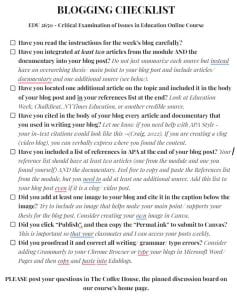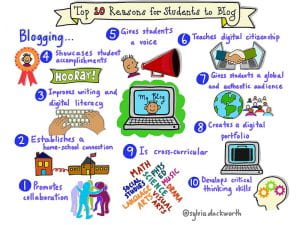Welcome to our course, EDU 2650, Critical Examination of Issues in Education! We are going to have a great time blogging this semester about many critical issues plaguing the education system today. Blogging has so many benefits for students and teachers alike. You can see some of the reasons to blog in the sketchnote image from Sylvia Duckworth and in this Edublog post “Step 1: Set Up Your Class Blog”. The post also teaches you how to set up your own blog in Edublog but be sure to use my invite code so your blog is attached to my blog! Here is the link to use to create your blog site – https://edublogs.org/?join-invite-code=10266828-edu2650-658ca600b5860. Use your first name and last initial as your Site Title and within your Site URL. If it is not available as a site URL, please add a number to your first name and last initial. Each week in this course you will explore a different critical issue by completing the work in the Canvas module. The critical issues include social justice, gender diversity, school violence, bullying/ cyberbullying, mental health, poverty/ homelessness, social-emotional learning/ mindfulness, addiction/ use, social media/ technology, multilingual learners, and home/ school connections.
Each module for each critical issue normally has a full-length documentary you must watch and incorporate into your blog post for the week. In addition, each module also has numerous articles about the topic. You must integrate at least TWO of the articles in your weekly blog post. It is your choice of which two articles you want to use that would fit the theme/ main idea of your blog post. In addition, and this is IMPORTANT so I’m using caps, you need to, on your own, find one additional article to use in your blog post that is recent – within the last two years (so basically, it needs to have a year of publication in either 2022, 2023, or 2024). The education system changes SO frequently and the more recent the additional article, the better. Don’t just find any old article as an additional article; instead, find a credible one from a news source such as Education Week, Edutopia, ChalkBeat, or other reputable education sources. (All the blue underlined text are links. You should do this in your blog post too when you cite a source!)
In summary, your blog post must include (and cite it in APA style formatting) 1) the documentary, 2) 2 articles found in the module, 3) one additional source you locate on your own from the above links, and lastly 4) include one CITED image (meme, gif, created by you on Canva, found through a Google search) that helps your reader understand your blog content/ supplements the content in a visual form. Images make everything better – don’t you think? BUT that’s not it when it comes to blogging; each week I will change up the blogging assignment on Canvas just to make this more interesting for all of us, so be sure to READ the assignment in Canvas (numbered for each required blog post) c-a-r-e-f-u-l-l-y!
More to come about our course and read the page on this blog called Blogging Guidelines for more details! I am looking forward to reading your blogs, watching your vlogs, and learning about your views on critical issues in education!
Would you please take the time now to write a short comment on this blog post? This way I know you read it and also you will have practice on how to post a comment as you will be required to read and comment on your classmates’ blogs all semester long. In your comment on my blog post, tell me which of the critical issues you are most interested in exploring in-depth and/ or the value you see in blogging (hint: take a look at Sylvia Duckworth’s sketchnote image on this post)
(Feel free to follow an easy commenting protocol called TAG: T – tell what you like about their post, A – ask a thoughtful question about their post, G – give a positive suggestion to expand their thinking)


 This is a blurry picture so click THIS LINK to read the blogging checklist
This is a blurry picture so click THIS LINK to read the blogging checklist